Having white spots on face or patches can be bothersome and unappealing. What does it mean to have patches or pimple-like spots on your face? In this post, we have covered a number of possible causes for this condition.Find out more as we provide treatment options on how to get rid of these spots with home remedies.
What are these white spots on your face? A number of skin conditions can be associated with this condition. Vitiligo is one of the common cause having these spots on the face. Infection such as yeast could also attribute to the appearance of facial spots. Other causes such as sun exposure or tanning, injury or allergy could also contribute to this condition.
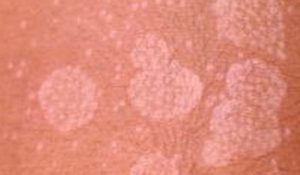
White spots on face are usually harmless. The condition can be mild or severe and can generally cover whole or part of the face surface. It is more common for the spots to cause irritation and itching. If you have white spots on face that lasts more than one week you need to visit your health care provider as soon as possible.
White spots on face pictures, images
Below find an image of white spots on face to help you understand the cause of your symptoms. Throughout the post, we have added more pictures to give you a visual aid on this condition.
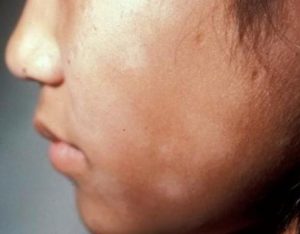
What causes white spots on face?
1. Yeast infection on face
Yeast infection on skin near the face may be the cause of these spots. This is due to the infection by candidiasis, where the skin is infected with a fungus- candida fungi. This type of infection n is fairly common and can infect any part of the skin including your face. However the infection is more common in moist parts of the body. The moist, warm and creased areas such as armpits and groin are more likely to be infected with the fungus.
Candida is a strain of fungus that skin holds in small amounts. However, when the yeast starts to grow and multiply in number, that’s when the problem start and your face may develop white spots. If this is not checked in time, the condition may worsen causing you to develop rash throughout your body. According to a research by the center for disease control (CDC), it is estimated that there exist more than 150 species of candida. However, the majority of infection are caused by Candida albicans.
Most of the spots caused by yeast infection are not that serious. The condition can easily be treated. However, uncontrolled infection can lead to a potential life-threatening problem, this is most common to people with weak immune system. If the infection is diagnosed at early stage, it could help prevent the spread to other parts of your body.
The following group of people are more prone to attacks by the fungus and could lead developing white spots on face:
- Infant
- Overweight people
- People with diabetes
- Those with inflammatory disorders
- People with weakened immune system
- Pregnant women.
- Those using topical corticosteroid are also at risk of having a yeast infection.
The treatment for candida skin infection is simple. Given the fact that the condition is not life threatening. Your doctor will diagnose you and once the cause of the rash has been established, your doctor will prescribe drying agents with antifungal creams. This will include drugs such as ketoconazole or clotrimazole, both of which are topical (you apply on top of the skin) and from a class of antifungal drugs known as azoles
2. Tinea versicolor
According to the American Academy of Dermatology, we all have yeast living on our skin. When the yeast grows out of control, we get a disease called tinea versicolor also known as pityriasis versicolor. Many people get tinea versicolor. It is one of the most common skin disease in the tropical and subtropical areas of the world.
Since the infection is as a result of yeast out growth, the factors possible for this kind of growth will include:
- Too much oil in your skin
- Hot climatic environments
- You sweat a lot
- Weak immune system.
Tinea versicolor is very contagious given that the yeast grows naturally on your skin. You could easily get infected through body contact with an infected person. The skin can affect people of any skin color and it is most prevalent in teens.
The acidic bleach from yeast causes the skin to develop a different color, creating spots and patches, the visible symptoms of the infection are:
- Colored patches on the skin surface.
- Itching and irritation
- Multiple spots on face.
- Dry and scaly patches
3. Vitiligo
Vitiligo is a skin condition that results in the loss of melanocytes of the skin. This results in white spots on your face. The patches maybe itchy and irritating giving a feeling of scratching. The cause of vitiligo is unknown, but it is however, believed to be as a result of an auto immune condition. A wild trauma on any area of the skin may also result in the development of vitiligo.
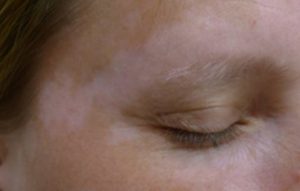
Apart from the face, vitiligo can also affect the hands, elbows and genital area. Vitiligo affects people of all skin, but it is easily noticeable in people with darker skin. The condition is not life threatening or contagious. But having white spots on your face can cause you to feel bad about yourself. Treatment can improve the condition but not cure the disease.
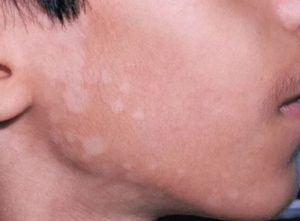
Apart from skin discoloration, the other signs to look for will include the following:
- Premature graying the hair on your scalp
- Change in in color of your retina
- Loss of color on the tissues inside your mouth
Though vitiligo has no cure, early medication and treatment will help in preventing further whitening and at least help return your skin to normal.
4. Idiopathic guttate hypomelanosis
White spots on face can also be as a result of idiopathic guttate hypomelanosis, a skin condition resulting in small flat white spots on the face. The condition is more common in individuals with light skin though it is also possible to dark skinned people. The condition is more common to old people say at their 40’s.
The causes of idiopathic gutate hypomelanosis are speculative. It is otherwise thought as being an inevitable part of ageing process- due to gradual reduction of melanocytes, other causes include sun damage
4. Pityiasis Alba
Pityiasis Alba is a skin disorder that mostly affects children and young adults. The exact cause is unknown. However, it is believed the condition is associated with eczema, a skin condition that result in scaly, itchy rashes on the skin surface.
People with this skin condition may develop white spots on face that are usually round, oval in shape. Using moisturize creams the spots may go away, but leave pale marks after the patches have faded away.
5. Sun exposure
Can excess exposure cause skin cancer? Yes there exist chances getting skin cancer by exposing your skin to excess ultraviolet rays. Having white spots on face as a result of sun exposure, a condition called PMLE polymorphic eruption, meaning a rash with many forms. This condition has nothing to do with skin cancer. The rash caused by PMLE follows a particular pattern. It starts when you have long exposure of sun rays mainly during winter and mostly common in country with high temperatures.
The Symptoms of sunburn include a painful and reddened skin. However, sunburn may not be immediately apparent. But by the time the skin starts to become painful and red, the damage has already been done. Severe sunburn may result in swelling and blisters.
To treat or ease the discomfort of sunburn:
- Apply a cold compress to the affected area.
- Take aspirin or acetaminophen (Tylenol) immediately after exposure to the sun to relieve sunburn discomfort and inflammation.
- Apply a cooling gel or ointment containing aloe Vera to the sunburned area.
- Avoid further sun exposure until the discomfort resolves.
6.Milia
Milia are small, white bump that typically appears on the nose, cheeks, and lips. The cysts occurs when keratin becomes trapped beneath the surface of the skin. Keratin is a strong protein that is found in the skin tissues, hair, and nail cells.
The infection can occur in people of more ages, but it is more common in newborns. The disease can easily be confused with Epstein pearl, which involves the appearance of harmless white-yellow cyst.
The cause of milia in newborn is believed to be triggered by hormones from the mother. Unlike baby acne, milia in newborns does not cause inflammation. According to Stanford School of medicine, infant with milia are born with it, whereas baby acne does not appear till the kid is few weeks. In adult milia is typically associated with:
- Burns
- Blisters from injury
- Long term steroid use
- Sun damage from long term exposure.
After you have been diagnosed and the cause of the white spot o face is established to be as a result of milia, your doctor will prescribe the following procedure to get rid of the cysts appearing on your face. The treatment will include:
- Chemical peels
- Deroofing which involves using a needle
- laser ablation, which involves using a small and focused laser to destroy the cyst
- surgical removal
- Cryotherapy that involves freezing the cysts.
Itchy white spots
What causes itchy white spots on face? Does itchy white spots mean I have skin cancer?
Having white spots on face can be worrisome. It can be irritating leave alone embarrassing. Though not life-threatening, white patches on face is a clear sign of an underlying health condition. Treating the condition is key in getting rid of the spots.
Most of the white bumps on face are painless, as the spots dry, become rough and make your skin feel irritating. It is more common for the condition to worsen during winter, when the level of humidity are at their lowest as a result of the skin getting drier and tender.
White spots on face of children
Are white spots on children as a result of cancer? Are white spots on face contagious? How do I get rid of white spot on my child’s face? For a parent, noticing the changes in your child’s face is a cause of worry.
Pityiasis and Milia are most common causes of white spots on kid’s skin. It is important to note that your child can develop the rash at any age. It could be as a result of chicken pox if the kid has never had it before. You need to see a doctor and avoid self-diagnosing the kid.
You don’t need to worry given that most of the white spots on the face are not life-threating. The patches are not disease, but a sign of an underlying medical condition. Once you visit your pediatrician, your child will be diagnosed and the underlying cause of the rash identify. Once this is done the doctor will prescribe the best medication and your child will be ok.
White pimple- like spots on face
What causes white pimple -like spots on face? You could be wondering, is a white pimple like spot on face a symptom of skin cancer? Most common cause of a pimple like cyst is milia on face, milia are small white bumps that occurs when keratin (a strong protein found in skin tissues) become trapped beneath the surface of the skin.
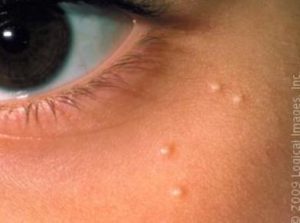
It is possible for you to get infected with milia regardless of your age or skin color. The cause of milia is unknown, but in newborn it is believed to be triggered by hormones from the mother. The infection in infants does not cause inflammation which is what differentiates it from baby acne.
You need to see your dermatologist to make sure the white pimple on your face are as a result of milia and not an underlying disease or illness. You may have trouble completely getting the cyst out of the pimple, this is because the process may be too painful.
How to heal, cure and treat white spots on face,
How to heal and treat white spots on face starts with identifying the cause of the spots. After you have visited your health care provider, some test will be carried out and the cause of the patches established. When this is done the doctor will prescribe the most appropriate cure.
Your dermatologist might recommend creams to help get rid of the white spots on your face. Most of these creams are also available over- the- counter. The most common creams will include:
- Topical creams with antioxidants
- Anti-dandruff cleanser
- Phototherapy medication which involve exposing your skin to controlled ultraviolet light
- For parasite caused patches, oral medication may be prescribed.
It is important to note that, insufficient amount of melanin in your body would lead to loss of healthy skin cells that replace the dead cells that fall off. As a result, it leads to the formation of white patches on your face and other parts of your skin.
How to get rid of white spots on face naturally with home remedies
Apart from conventional medication, you can treat most of the skin condition at home. It is important to note that, after you have used the following home remedies and the patches fails to disappear or the irritation and itching or the spots start to spread to other body parts, it Is right time to see your dermatologist.
You could try the following home remedies, and we assure you will be able to soothe the skin and reduce the itching and discomfort caused by the white spots on face.
a) Olive oil
Applying olive oil on your face on the parts with the spots can be helpful in easing the irritation. Olive oil is rich in vitamin E and antioxidants, which help soothe your skin and reduce itching. You could also use a combination of olive oil and honey. Simply rub the mixture a few times daily until the spots heal completely.
Castor oil and coconut oil will also help heal the white spots naturally. A combination of vitamin E oil and liver oil is thus a good remedy.
b) Baking soda
You could also use baking soda, which help dry skin rashes and patches on the face. It also relieves the itching and inflammation associated with rashes and spots. Here’s how to:
- Add a 50 grams of baking soda to 150 milliliters of water.
- Apply the mixture on the affected area,
- Leave it on for a few minutes before rising it off.
- Do this repeatedly for a few days.
Note you can use coconut oil in place of water to make a paste that you can apply on the affected area. (You should not leave baking soda on your skin for long as this would cause further irritation).
c) Oatmeal
Due to the soothing and anti-inflammatory properties of oatmeal, it’s good for alleviating skin irritation and inflammation. It’s thus excellent for rashes caused by eczema, sun burn, chicken pox and allergies. Do the following:
- grind raw oatmeal in a blender,
- Combine one-half cup of oatmeal, a quarter cup of milk powder and two tea spoon of honey.
- Put this mixture in a muslin cloth, tie and place it in a bath tab filled with warm water.
- Soak in the milky bath water for 20 minutes.
- Pat dry and moisturize your skin, repeat daily for a few days.
d) Aloe Vera
Aloe Vera has anti-inflammatory, emollient, antibacterial and antifungal properties. It’s excellent for treating number of skin ailments including white spots on face. Apart from healing, it also soothes the skin, relieves itching:
- Extract fresh Aloe Vera gel from an aloe leaf.
- Apply it on the affected area.
- Leave it on for at least 20 minutes, and then rinse it off.
- Do this at least three times a day until the rash clears.
If you do not have fresh aloe Vera gel, you can buy aloe Vera gel or extract from any retail store near you.
e) Apple cider vinegar
Raw and organic apple cider vinegar is another excellent home remedy to treat skin ailments and ease itching. Moreover, its acetic acid content helps fight skin infections that could be causing or aggravating the problem.
- Dip a cotton ball in apple cider vinegar and place it on the affected area.
- Leave it on for a few minutes, and then remove the cotton ball.
- Do this several times a day for a few days or until your rash clears.
Note: If apple cider vinegar causes irritation, try diluting it with water before applying it. If the irritation persists, then try another remedy.
f) Turmeric
Turmeric is an excellent skin rejuvenating agent and can help treat Vitiligo effectively. Turmeric also contains antibacterial properties that help get rid of bacteria causing the infection. Added to this is the potent antiseptic property of turmeric that would promote quick healing of the infected skin.
Mix some turmeric powder and a few drops of mustard oil to form a paste. Apply this paste over the white patches once in the morning and evening on a daily basis. Alternatively, you can crush a few neem leaves, mix them with some turmeric powder and water, and apply the paste on the white patches on a daily basis (twice for quick results). Continue this particular home treatment until the white patches disappear.
d) Cabbage juice
Cabbage is another natural home remedy that you can apply on the white spots on your face to get rid of them and prevent recurrences. You only need to grind a few cabbage leaves to extract the juice, apply the juice on the white spots for about 15 minutes for a week daily. You could also boil some cabbages and use to the resultant soup to wash your face with it, wait for 10 minutes before finally rinsing it off.
Sources and references
- http://www.nhs.uk/Conditions/Vitiligo/Pages/Symptoms.aspx
- http://www.healthline.com/health/discolored-skin-patches
- http://www.searchhomeremedy.com/excellent-home-remedies-for-white-patches-2/
- http://www.myhealthtips.in/2013/09/how-to-get-rid-of-white-patches-on-skin.html
- http://www.md-health.com/White-Spots-On-Face.html
